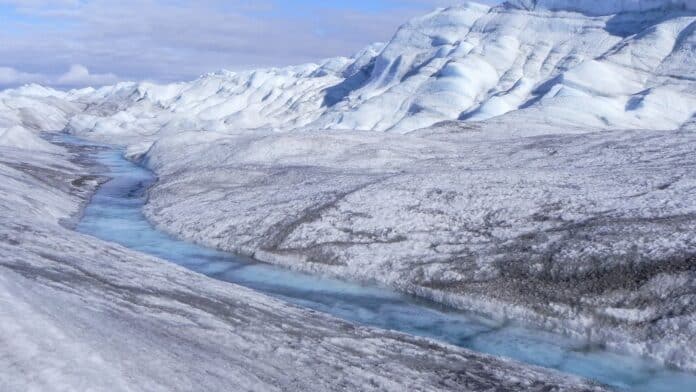The Greenland Ice Sheet (GrIS) has transitioned from near-zero mass loss in the 1990s to significant and sustained annual mass losses since the mid-2000s. While the satellite. It is now the largest cryospheric contributor to sea level rise.
The uncertainty associated with ice sheet motion plagues sea level rise predictions. This uncertainty arises from imperfect representations of physical processes, including basal slip and internal ice deformation, with ice sheet models largely incapable of reproducing borehole-based observations.
The RESPONDER project, funded by the European Research Council, explores the dynamics of the Greenland Ice Sheet using a combination of physical measurements and computer modeling. As a part of project, using computer modeling techniques based on earlier fiber-optic measurements from the Greenland Ice Sheet, an international team of scientists at the University of Cambridge built a more detailed picture of the behavior of the world’s second-largest ice sheet.
The movement of glaciers in Greenland is more complicated than previously understood, suggests this study, with deformation in areas of warmer ice containing trace amounts of water accounting for motion that was frequently considered to be brought on by sliding where the ice hits the bedrock below.
The borehole measurements also revealed that the base of the ice contains only trace amounts of water, up to about 2%. This mixed ice-water layer, also known as temperate ice, ranged in thickness from eight meters in some areas of the ice sheet to 70 meters in others.
First author Dr. Robert Law, who completed the work while based at Cambridge’s Scott Polar Research Institute and is now based at the University of Bergen, said, “The addition of even tiny amounts of water softens the ice considerably, transforming it into a unique material with substantially altered mechanical characteristics. We wanted to know why the thickness of this layer varied so much because if we don’t fully understand it, our models of ice sheet behavior won’t fully capture the physical processes occurring in nature.”
Co-author and RESPONDER project leader Professor Poul Christoffersen, who is based at SPRI, said, “The textbook view of glacier motion is that it occurs with a neat partitioning of basal sliding and internal deformation and that both are well understood. But that’s not what we observed when we looked carefully at boreholes with new techniques. With less detailed observations in the past, it was difficult to get a really good picture of how the ice sheet moves and even more challenging to replicate it with computer models.”
Based on earlier barehole measurements, scientists have developed a model that considers all new observations. They mainly incorporated natural variations in the landscape at the base of the ice, which, in Greenland, is full of rocky hills, basins, and deep fjords.
The scientists discovered that when a glacier crosses a significant obstruction or elevation, there is a deformation and heating impact that occasionally reaches several hundred meters from the ice sheet‘s base. This effect was previously ignored in models.
Law said, “The stress on the ice base is highest at the tops of these hills, which leads to more basal sliding. But so far, most models have not accounted for all these landscape variations.”
By incorporating these variations, the model also showed that a variable layer of temperate ice forms as the glacier moves over the landscape, whether fast- or slow-moving. Although it coincides with past borehole observations, the thickness of this temperate ice layer deviates significantly from conventional modeling techniques used to forecast sea level rise from ice sheets.
Law said, “Because of this hilly landscape, the ice can go from sliding across its base almost entirely to hardly sliding at all, over short distances of just a few kilometers. This directly influences the thermal structure — if you’ve got less basal sliding, you’ve got more internal deformation and heating, which can lead to the layer of temperate ice getting thicker, altering the mechanical properties of the ice over a broad area. This temperate basal ice layer can act like a deformation bridge between hills, facilitating the fast motion of the much colder ice directly above it.”
Scientists are now looking forward to using this study to develop more accurate descriptions of ice motion for the ice sheet models that predict future sea level rise.
Journal Reference:
- Robert Law, Poul Christoffersen, Emma MacKie, Samuel Cook, Marianne Haseloff and Olivier Gagliardini. The complex motion of Greenland Ice Sheet outlet glaciers with basal temperate ice. Science Advances, 2023 DOI: 10.1126/sciadv.eabq5180
